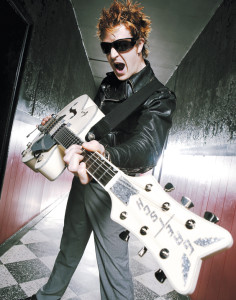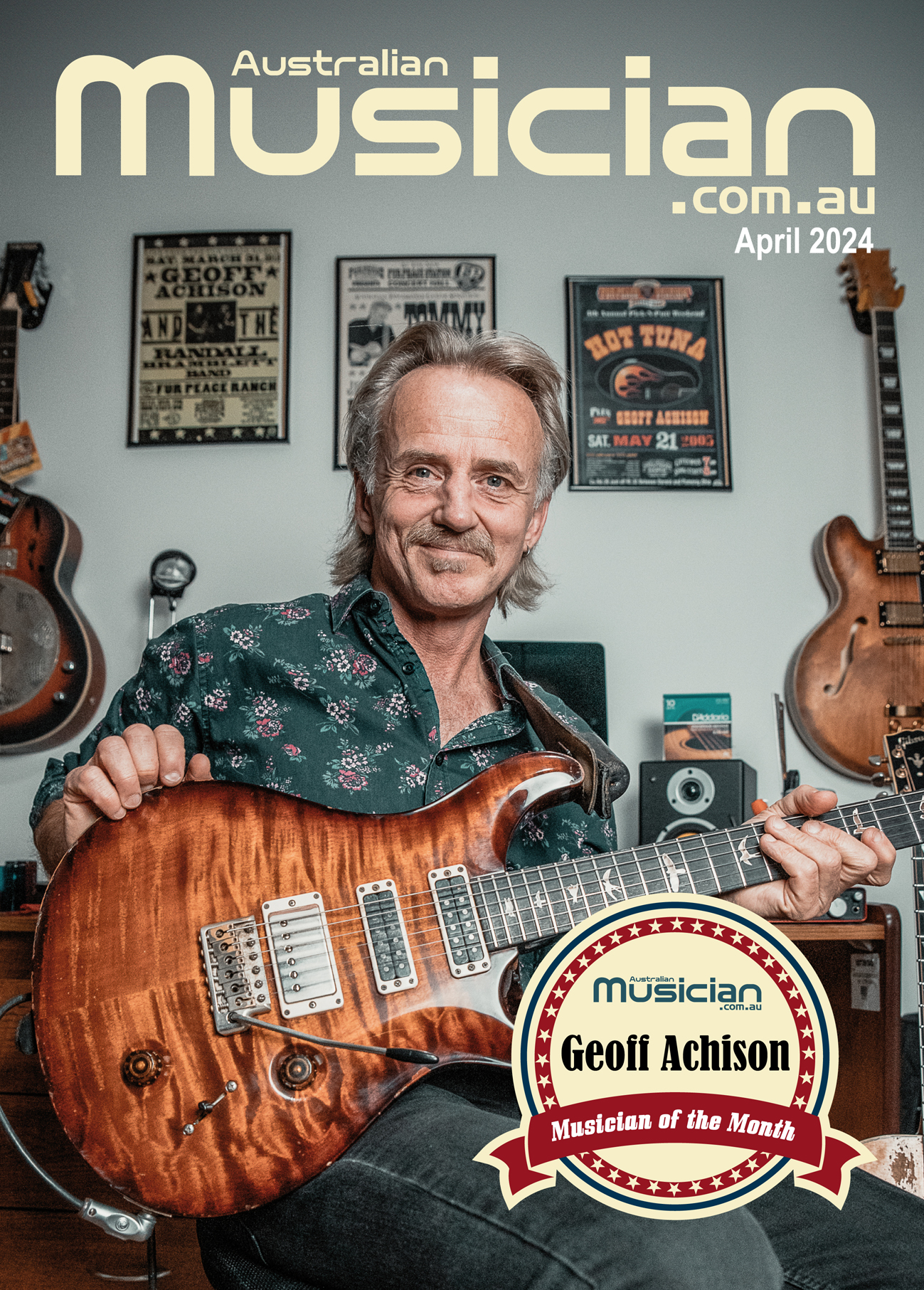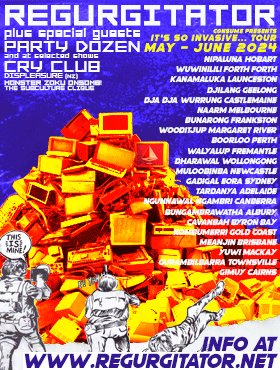THE LIVING END – CHRIS CHENEY ON HIS NEW SIGNATURE GRETSCH GUITAR and a chat with Gretsch’s Mike Lewis
June 12, 2008 | Author: Greg Phillips
 In Gretsch’s 125th anniversary year, the company chose to honour The Living End’s amazing guitarist Chris Cheney by creating his own production line signature model Gretsch guitar. Greg Phillips spoke to Chris about the guitar and the new Living End album ‘White Noise’.
In Gretsch’s 125th anniversary year, the company chose to honour The Living End’s amazing guitarist Chris Cheney by creating his own production line signature model Gretsch guitar. Greg Phillips spoke to Chris about the guitar and the new Living End album ‘White Noise’.
How were you initially approached in regard to doing a signature model Gretsch?
It’s probably a couple of years ago now. I’d got to know the guys at Fender (local distributor for the Gretsch brand) in Australia due to my association with Gretsch. They figured that I didn’t really play anything else. We got talking about different pickups, different body shapes and necks. The idea came up to do a custom model, where they would get Gretsch to make me a one-off of this kind of body, and that kind of Bigsby, in that colour or whatever. From there it grew to … a phone call I got one day from Fender (Australia)… and there was talk of actually doing a signature model, which absolutely blew me away. It’s one thing to get a custom model made, but to get a signature model which will go into production … It’s been two years of going backwards and forwards and talking.
I met with Mike Lewis from Fender (FMIC USA) when we played the Hordern Pavilion in Sydney (two years ago). We sat down then and he asked if they did something, what would I like? Basically there was no blueprint for this guitar. It was me saying … well I love the way the 6120’s body feels. I love the look of the White Falcon neck. Obviously I’m a big fan of the TV Jones pickups. I wanted it to be white, because I really dig the way the Falcon looks. So it’s a real kind of Frankenstein guitar. But I have to tell you, I am super happy. They’ve done three prototypes and the third one came straight out of the case and played like a gem. It’s been a long road but we’ve nailed it and I’m stoked, really honoured.
Last time we spoke, it was when we did the cover story with you and Ian Moss and you had a prototype in your rack. What kind of things were you asking them to change along the way?
The first one came with a zero fret … that we didn’t request. We actually went to the Japanese factory when we were there on tour and that’s when I received the first one. So I got to look at it in Japan for the first time. It had a zero fret, so I don’t know if that was something that was lost in translation. We got rid of that. That one had Classic Plus pickups on the bridge and we ended up putting a Powertron in the neck. We also ended up putting a Bigsby on it. It had like a straight G-cutout tailpiece that comes on the anniversary models. After a while I thought, you know what, this is a Gretsch and the Bigsby really is an integral part. I found myself playing my Gretschs with Bigsbys more often than not, so I had to approach them about putting a Bigsby put on it. We got the trestle bracing, but there were a few things we tweaked along the way.
The silver sparkle binding, was that your idea?
To go with the silver instead of the gold? I love the gold but it has been done. I figured it would look a little less Liberace I suppose if we went for silver. I wanted it to kind of look a little more rock and roll, less Rodeo Drive. Obviously the Falcon is the most beautiful guitar there is, but I thought if there was a way of looking like that but in a more road-ready guitar, it would be good.
Did you deal directly with TV Jones in relation to the development of this guitar?
I did. When discussing the pickups and things like height. I really love the way the pickups in the (Brian) Setzer model that I have really bark. The Classic pickups that came in the first protoype didn’t really have that, so I spoke to him about whether the Setzer pickups had been souped up at all. I wanted to know whether there was any unforeseen magic going on. He assured me that they were standard. I just wanted to get his opinion on certain things. I’ve got quite a few pickups off him over the years and did a poster for him a while ago, which was a real honour. He’s a great guy and super intelligent. To be endorsed by Gretsch the way he is, it’s pretty phenomenal.
Will there be any public launch for the guitar either here or in America?
I think so. I’m not sure what the plans are but I want to get behind it. I really believe they have done a great job with it. Obviously I am happy to help out in any way possible.
Let’s talk about the new album now. What was the mind set when discussing the new album? Was it here’s bunch of songs, let’s record them or was it more than that?
Well it always starts out with a bunch of songs. I find it very difficult to write in a particular style. I can never really put those barriers on my writing. I have to let whatever has to come out … come out. It became apparent very early on for us that we wanted to make a record that was more gutsy, more of a representation of our live show. I’ve always felt that we played great shows but perhaps haven’t translated that to record as well as we’d liked. I know it’s a struggle every band has to deal with and fight with. There were a few songs that came along early in the writing process that were really kind of meat and potatoes, solid rock and roll riff songs. We thought OK, there’s the template right there. That’s the way we should continue the writing and focus on those kinds of songs. If we get a riff that is really killer but we don’t have a song, then let’s write a song around it. We wanted this to be a really big rock and roll guitar album. There are a few songs which go into areas where we haven’t delved before. It’s hard to explain but they are very anthemic, very huge sounding heavy songs. There’s a lot more depth to them. For some reason they felt more natural than anything we’ve done for a long time. I think it’s going to surprise a few people but there’s a lot more guitar licks and heavy riffs than we’ve done before. It’s almost hard rock in a way, but done with a Gretsch and a double bass and in our own style. We’re so excited.
What was producer John Agnello like to work with compared to Nick Launay, who did your last album?
He was great. We love Nick but John was really different. He’s a lot less pedantic. He left some rough edges there. He moved through it quicker which is exactly what we wanted, someone who was going to crack the whip and say that’s good enough let’s move on, rather than us dissecting every little part of it. That’s one of the keys to making the kind of record we wanted to make. In a live situation we just get up there and do it and play a million miles an hour. That’s the record we wanted. He was really good at enforcing that, making sure things weren’t too perfect. Lots of harmonies and acoustic guitars and even strings on it but there’s something about it. It still sounds raw and like a real band, not over-produced.
Apart from the string players, were there any other guest musicians?
We did have a guy named Franz (Nicolay) who is in a band called The Hold Steadys. He came in to do some piano. There were a couple of songs in there we wanted to sound almost Springsteen-like. I don’t know whether it was just being in New Jersey recording or what. But that’s what he specialises in, really thumpin’ piano. There’s one song in particular where on the verses he played some nice flourishes, but then the chorus breaks into an almost Little Richard kind of pounding. We have never had piano on any of our songs before. There’s a lot of life and colour to all of the songs, but still sound very rock. It’s not soft.
Does it have a name?
Yeah .. White Noise!
Is that a difficult thing to do, decide the name of an album?
Oh My God. You have no idea. You need to ask my psychiatrist. That’s one of the songs, ‘White Noise’ and it’s potentially a single. As soon as we came up with that song, we thought it would be a great album title. We know how to make a racket when we want to so ‘White Noise’ is the title.
Ties in nicely with the guitar too!
Well, yeah I’d never thought of that.
With the release of the guitar and album around the same time, do you see it as a real opportunity to have a decent crack at America?
I do. I still think we have a great chance here. I think we have age on our side and we have a really loyal live following. Everyone in the industry is aware of the band, and I think from the feedback we get, everybody would like to see us do something here. Whether that means we can or not. It’s kind of up to the songs and up to us. We’re quite willing to get in a van and tour over here again. Who knows. Every time we play over here, they say, man you guys have got something that we don’t see in other bands here.
The signature model Gretsch will be available through your local authorised Gretsch dealer around late August. ‘White Noise’ is released July 18
MIKE LEWIS ON THE CHENEY MODEL GRETSCH:
Vice President of Product Marketing for FMIC and Gretsch, Mike Lewis was recently in Australia. Greg Phillips caught up with Mike to ask a few questions about the new Cheney model guitar.
How does a signature model Gretsch guitar begin?
Gretsch guitars are ingrained in the collective “DNA” of our musical culture as a great portion of the “library” of popular music has been written and recorded by stalwart artists on Gretsch instruments. Many of these artists have Gretsch signature models because of that fact. Additionally, there are musicians who have taken that traditional sound to another level altogether – and for that reason, we’ve released signature models for them as well.
What were the origins of the Chris Cheney model?
Chris has been a dedicated Gretsch player for a long time. A few years back, a longtime friend and now Gretsch distributor (Fender Australia) reached out to us regarding a possible Chris Cheney signature model. I flew to Australia and met with Chris to discuss everything he needed in his signature instrument. We sketched some ideas out on a piece of paper and eventually designed his dream guitar.
From all accounts Chris Cheney had a lot of freedom with the creation of his signature guitar. Is it difficult striking a balance between what an artist wants and keeping in line with company traditions and guidelines?
Not at all. As I mentioned, Chris has been championing Gretsch guitars for many years. Chris, like all our signature artists, understands what That Great Gretsch Sound! is all about.
The TV Jones association goes back a couple of decades. What is it about Tom’s pickups that keep the association so strong?
It’s not just about the pickups, it’s about Tom. He understands Gretsch tone above all else and has been a central figure in Gretsch Guitar design for many years – as far back as Brian Setzer’s initial signature model. Without his ideas, knowledge and experience, Gretsch wouldn’t be all that it is today.
Cheney is not the first Australian to have a signature model guitar, there’s also the Malcolm Young Duo Jet. How and when did that series begin?
The relationship with Malcolm goes back a few decades as well. His signature model was one of the first developed after Fred Gretsch reintroduced the guitars in the late ‘80s.
Tell me about the ML bracing you’ve implemented.
ML bracing is the result of developing a “middle-ground” between sound post and Trestle bracing designs. While sound post designs create full hollow-body sounds with great overtones, Trestle bracing— which developed from Chet Atkins—allows guitarists to play at louder volumes without unwanted feedback. ML bracing has the advantages of both by providing full hollow-body tones with controllable feedback.
How would you explain to the man on the street with no real knowledge of guitar history, why it’s important to keep a record of serial numbers and be so fastidious with a guitar’s history?
Not unlike classic car fanatics, guitarists are extremely passionate about their instruments. A guitar’s history, and its place in history, can sometimes be as important to a player, hobbyist or collector as the way it sounds, looks and feels.
What other signature models can we expect soon? We’re always working on new things. And, while I can’t tell you what they are; I assure you – Gretsch fans will be happy!


